Fund Management: Investment Portfolio Analysis & UK Economic Review
VerifiedAdded on 2023/06/13
|19
|5042
|291
Report
AI Summary
This report analyzes an investment portfolio by investing in stocks on the FTSE 250 in the UK, from the perspective of a fund manager. The initial £2 million investment is equally distributed across power, retail/personal consumption, and technology/communication sectors. The analysis evaluates the UK's economic condition, provides sector-specific information, and assesses investment decisions using ratio analysis. The report covers the period from March 5th to March 29th, evaluating returns generated from the trades, and includes an analysis of the UK economic situation as of February 2018, sector reports on power, retail, and technology, and a rationale for investment decisions based on economic and sector analysis. It also evaluates the performance of companies through ratio analysis and discusses how the investment meets the overall strategy.
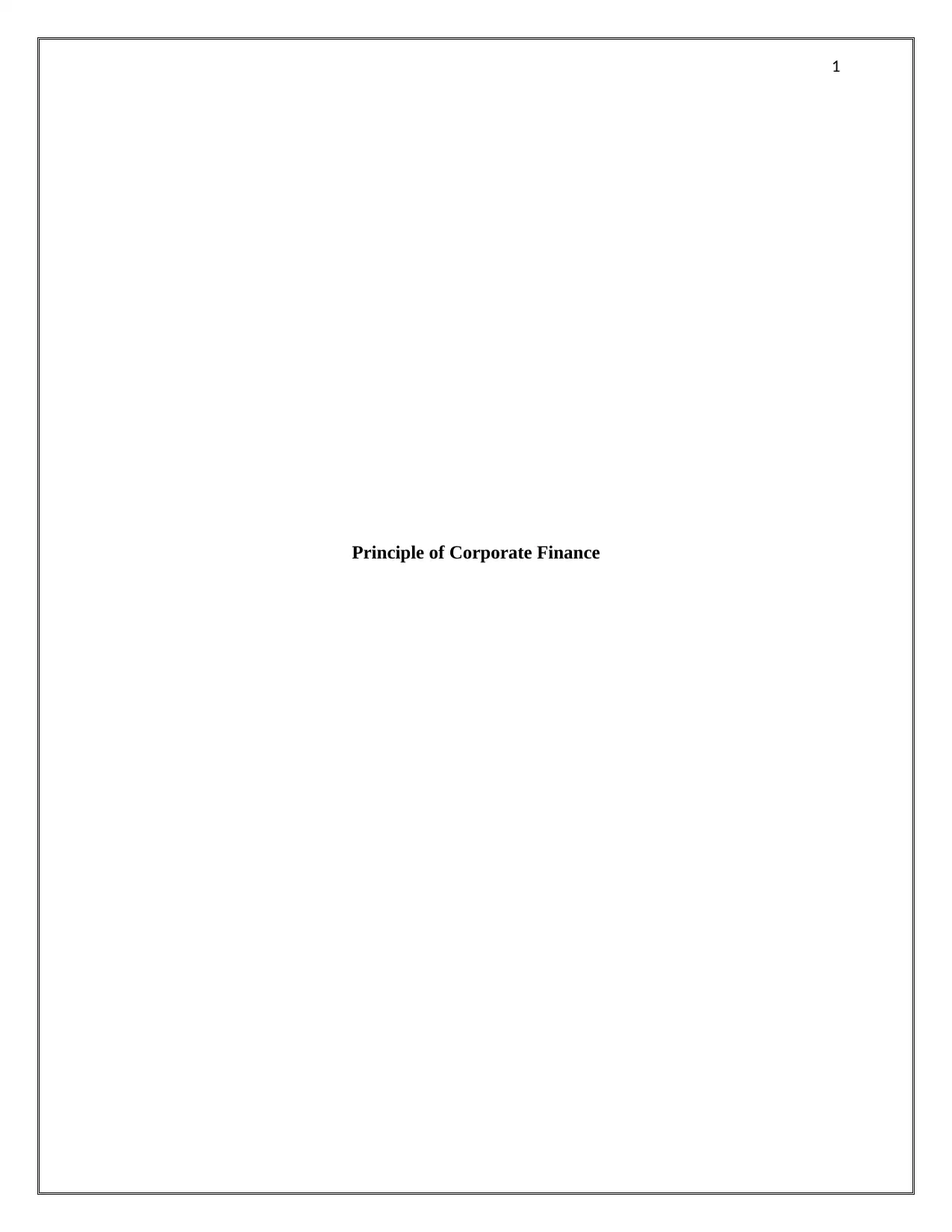
1
Principle of Corporate Finance
Principle of Corporate Finance
Paraphrase This Document
Need a fresh take? Get an instant paraphrase of this document with our AI Paraphraser
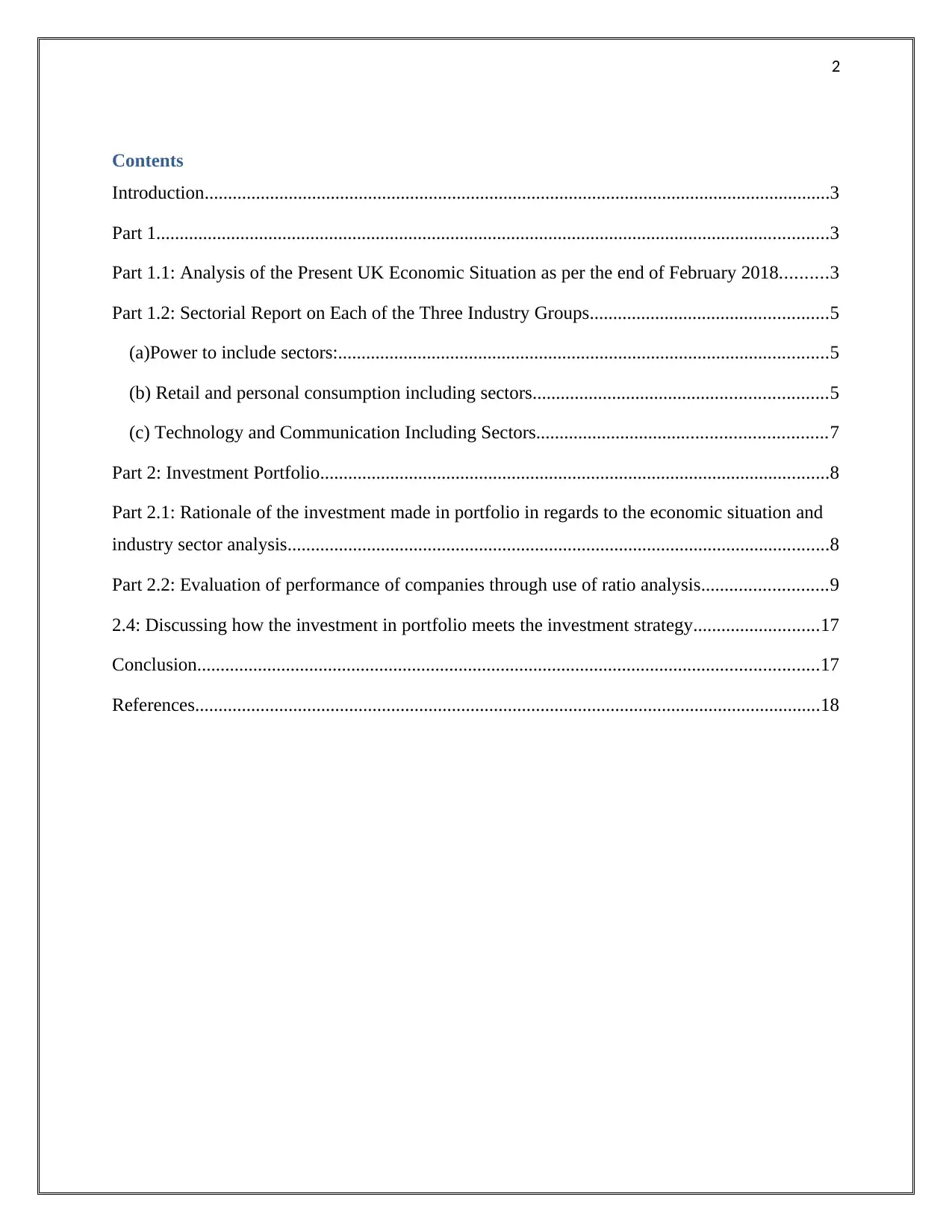
2
Contents
Introduction......................................................................................................................................3
Part 1................................................................................................................................................3
Part 1.1: Analysis of the Present UK Economic Situation as per the end of February 2018..........3
Part 1.2: Sectorial Report on Each of the Three Industry Groups...................................................5
(a)Power to include sectors:.........................................................................................................5
(b) Retail and personal consumption including sectors...............................................................5
(c) Technology and Communication Including Sectors..............................................................7
Part 2: Investment Portfolio.............................................................................................................8
Part 2.1: Rationale of the investment made in portfolio in regards to the economic situation and
industry sector analysis....................................................................................................................8
Part 2.2: Evaluation of performance of companies through use of ratio analysis...........................9
2.4: Discussing how the investment in portfolio meets the investment strategy...........................17
Conclusion.....................................................................................................................................17
References......................................................................................................................................18
Contents
Introduction......................................................................................................................................3
Part 1................................................................................................................................................3
Part 1.1: Analysis of the Present UK Economic Situation as per the end of February 2018..........3
Part 1.2: Sectorial Report on Each of the Three Industry Groups...................................................5
(a)Power to include sectors:.........................................................................................................5
(b) Retail and personal consumption including sectors...............................................................5
(c) Technology and Communication Including Sectors..............................................................7
Part 2: Investment Portfolio.............................................................................................................8
Part 2.1: Rationale of the investment made in portfolio in regards to the economic situation and
industry sector analysis....................................................................................................................8
Part 2.2: Evaluation of performance of companies through use of ratio analysis...........................9
2.4: Discussing how the investment in portfolio meets the investment strategy...........................17
Conclusion.....................................................................................................................................17
References......................................................................................................................................18
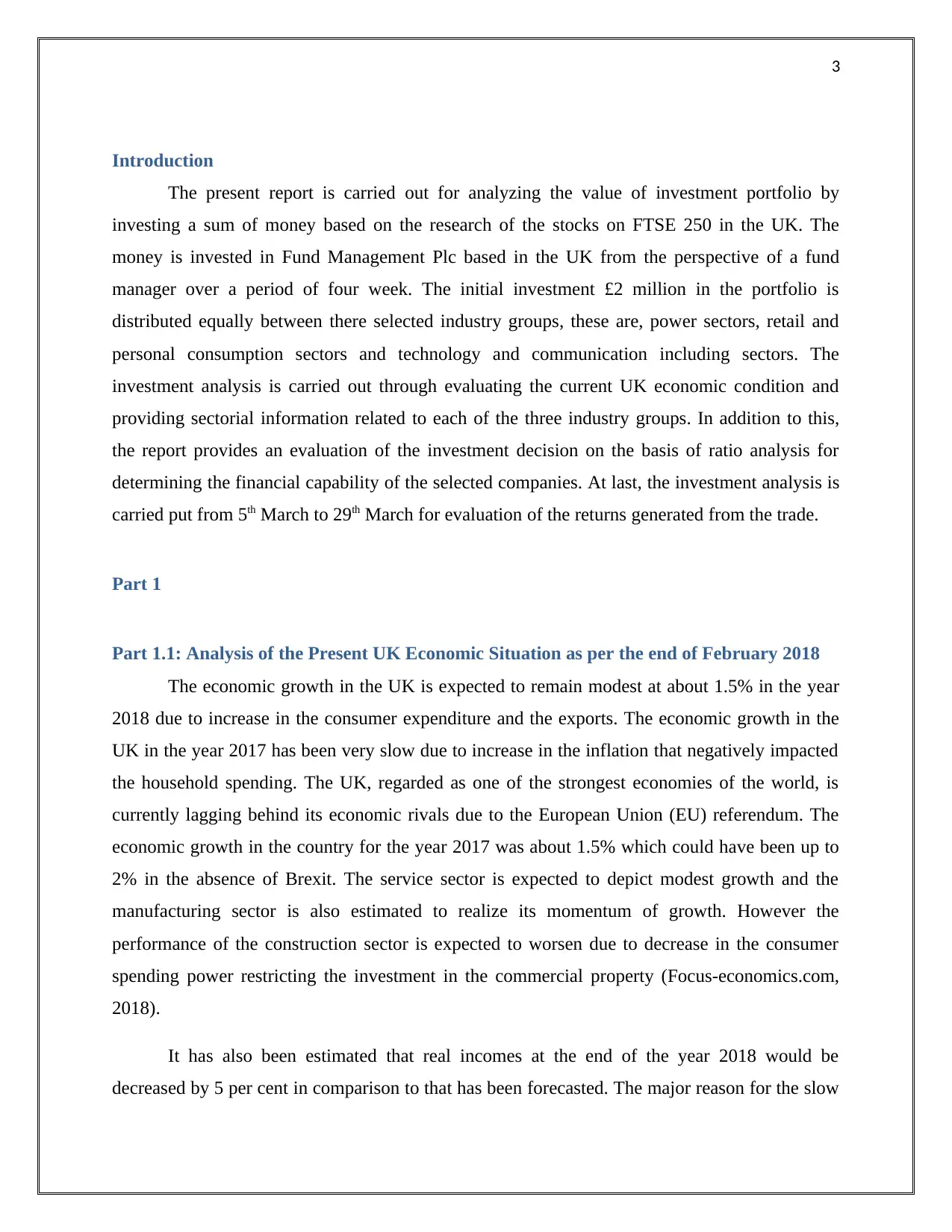
3
Introduction
The present report is carried out for analyzing the value of investment portfolio by
investing a sum of money based on the research of the stocks on FTSE 250 in the UK. The
money is invested in Fund Management Plc based in the UK from the perspective of a fund
manager over a period of four week. The initial investment £2 million in the portfolio is
distributed equally between there selected industry groups, these are, power sectors, retail and
personal consumption sectors and technology and communication including sectors. The
investment analysis is carried out through evaluating the current UK economic condition and
providing sectorial information related to each of the three industry groups. In addition to this,
the report provides an evaluation of the investment decision on the basis of ratio analysis for
determining the financial capability of the selected companies. At last, the investment analysis is
carried put from 5th March to 29th March for evaluation of the returns generated from the trade.
Part 1
Part 1.1: Analysis of the Present UK Economic Situation as per the end of February 2018
The economic growth in the UK is expected to remain modest at about 1.5% in the year
2018 due to increase in the consumer expenditure and the exports. The economic growth in the
UK in the year 2017 has been very slow due to increase in the inflation that negatively impacted
the household spending. The UK, regarded as one of the strongest economies of the world, is
currently lagging behind its economic rivals due to the European Union (EU) referendum. The
economic growth in the country for the year 2017 was about 1.5% which could have been up to
2% in the absence of Brexit. The service sector is expected to depict modest growth and the
manufacturing sector is also estimated to realize its momentum of growth. However the
performance of the construction sector is expected to worsen due to decrease in the consumer
spending power restricting the investment in the commercial property (Focus-economics.com,
2018).
It has also been estimated that real incomes at the end of the year 2018 would be
decreased by 5 per cent in comparison to that has been forecasted. The major reason for the slow
Introduction
The present report is carried out for analyzing the value of investment portfolio by
investing a sum of money based on the research of the stocks on FTSE 250 in the UK. The
money is invested in Fund Management Plc based in the UK from the perspective of a fund
manager over a period of four week. The initial investment £2 million in the portfolio is
distributed equally between there selected industry groups, these are, power sectors, retail and
personal consumption sectors and technology and communication including sectors. The
investment analysis is carried out through evaluating the current UK economic condition and
providing sectorial information related to each of the three industry groups. In addition to this,
the report provides an evaluation of the investment decision on the basis of ratio analysis for
determining the financial capability of the selected companies. At last, the investment analysis is
carried put from 5th March to 29th March for evaluation of the returns generated from the trade.
Part 1
Part 1.1: Analysis of the Present UK Economic Situation as per the end of February 2018
The economic growth in the UK is expected to remain modest at about 1.5% in the year
2018 due to increase in the consumer expenditure and the exports. The economic growth in the
UK in the year 2017 has been very slow due to increase in the inflation that negatively impacted
the household spending. The UK, regarded as one of the strongest economies of the world, is
currently lagging behind its economic rivals due to the European Union (EU) referendum. The
economic growth in the country for the year 2017 was about 1.5% which could have been up to
2% in the absence of Brexit. The service sector is expected to depict modest growth and the
manufacturing sector is also estimated to realize its momentum of growth. However the
performance of the construction sector is expected to worsen due to decrease in the consumer
spending power restricting the investment in the commercial property (Focus-economics.com,
2018).
It has also been estimated that real incomes at the end of the year 2018 would be
decreased by 5 per cent in comparison to that has been forecasted. The major reason for the slow
⊘ This is a preview!⊘
Do you want full access?
Subscribe today to unlock all pages.

Trusted by 1+ million students worldwide
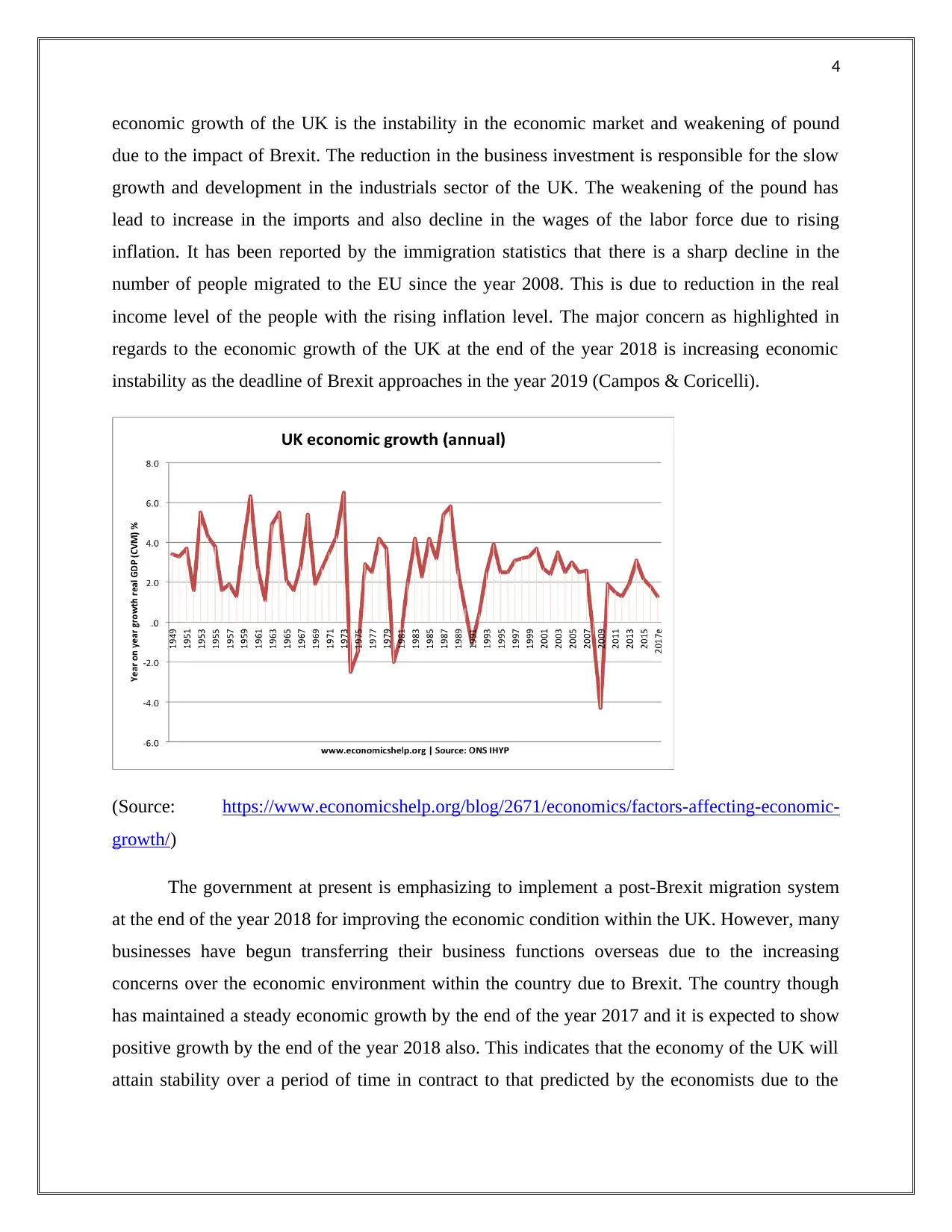
4
economic growth of the UK is the instability in the economic market and weakening of pound
due to the impact of Brexit. The reduction in the business investment is responsible for the slow
growth and development in the industrials sector of the UK. The weakening of the pound has
lead to increase in the imports and also decline in the wages of the labor force due to rising
inflation. It has been reported by the immigration statistics that there is a sharp decline in the
number of people migrated to the EU since the year 2008. This is due to reduction in the real
income level of the people with the rising inflation level. The major concern as highlighted in
regards to the economic growth of the UK at the end of the year 2018 is increasing economic
instability as the deadline of Brexit approaches in the year 2019 (Campos & Coricelli).
(Source: https://www.economicshelp.org/blog/2671/economics/factors-affecting-economic-
growth/)
The government at present is emphasizing to implement a post-Brexit migration system
at the end of the year 2018 for improving the economic condition within the UK. However, many
businesses have begun transferring their business functions overseas due to the increasing
concerns over the economic environment within the country due to Brexit. The country though
has maintained a steady economic growth by the end of the year 2017 and it is expected to show
positive growth by the end of the year 2018 also. This indicates that the economy of the UK will
attain stability over a period of time in contract to that predicted by the economists due to the
economic growth of the UK is the instability in the economic market and weakening of pound
due to the impact of Brexit. The reduction in the business investment is responsible for the slow
growth and development in the industrials sector of the UK. The weakening of the pound has
lead to increase in the imports and also decline in the wages of the labor force due to rising
inflation. It has been reported by the immigration statistics that there is a sharp decline in the
number of people migrated to the EU since the year 2008. This is due to reduction in the real
income level of the people with the rising inflation level. The major concern as highlighted in
regards to the economic growth of the UK at the end of the year 2018 is increasing economic
instability as the deadline of Brexit approaches in the year 2019 (Campos & Coricelli).
(Source: https://www.economicshelp.org/blog/2671/economics/factors-affecting-economic-
growth/)
The government at present is emphasizing to implement a post-Brexit migration system
at the end of the year 2018 for improving the economic condition within the UK. However, many
businesses have begun transferring their business functions overseas due to the increasing
concerns over the economic environment within the country due to Brexit. The country though
has maintained a steady economic growth by the end of the year 2017 and it is expected to show
positive growth by the end of the year 2018 also. This indicates that the economy of the UK will
attain stability over a period of time in contract to that predicted by the economists due to the
Paraphrase This Document
Need a fresh take? Get an instant paraphrase of this document with our AI Paraphraser
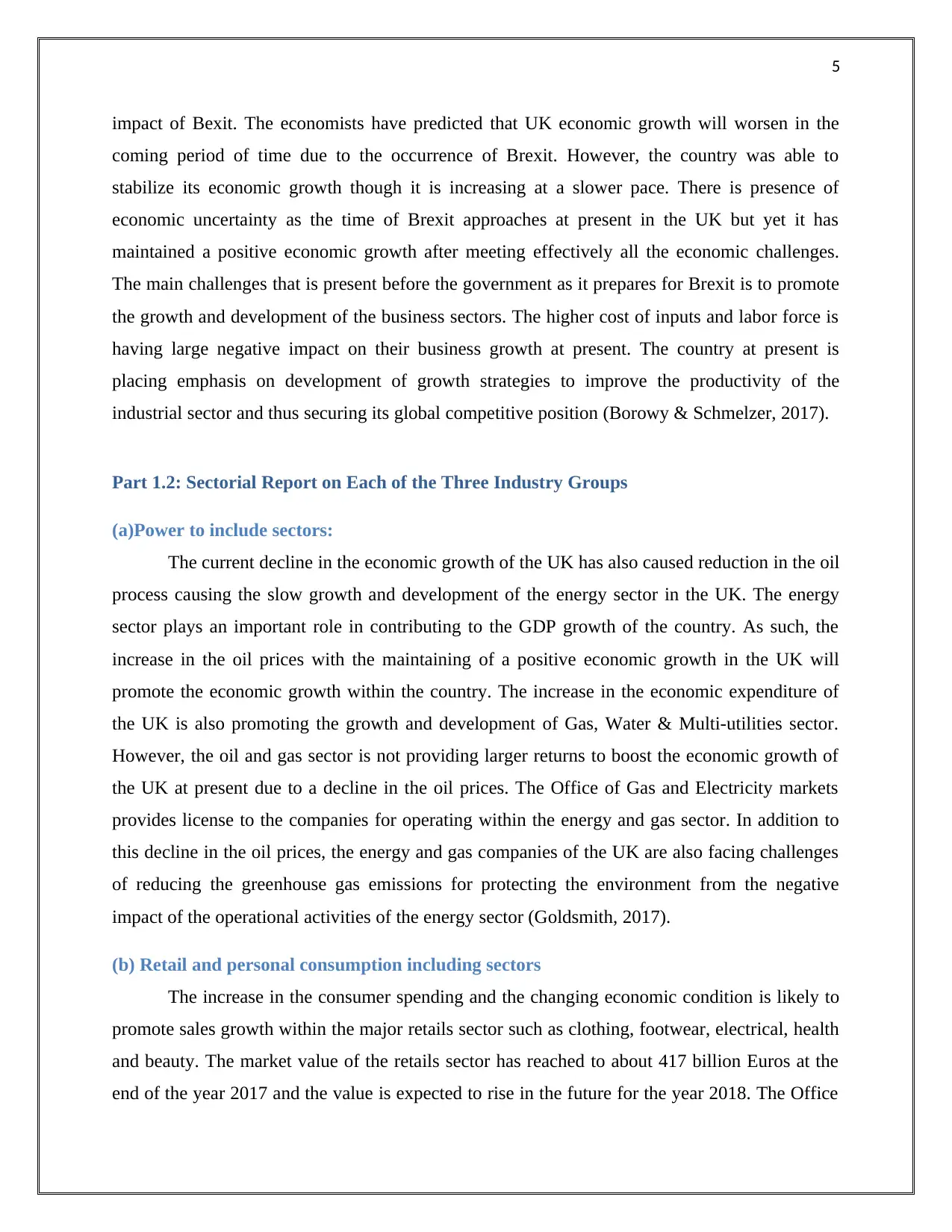
5
impact of Bexit. The economists have predicted that UK economic growth will worsen in the
coming period of time due to the occurrence of Brexit. However, the country was able to
stabilize its economic growth though it is increasing at a slower pace. There is presence of
economic uncertainty as the time of Brexit approaches at present in the UK but yet it has
maintained a positive economic growth after meeting effectively all the economic challenges.
The main challenges that is present before the government as it prepares for Brexit is to promote
the growth and development of the business sectors. The higher cost of inputs and labor force is
having large negative impact on their business growth at present. The country at present is
placing emphasis on development of growth strategies to improve the productivity of the
industrial sector and thus securing its global competitive position (Borowy & Schmelzer, 2017).
Part 1.2: Sectorial Report on Each of the Three Industry Groups
(a)Power to include sectors:
The current decline in the economic growth of the UK has also caused reduction in the oil
process causing the slow growth and development of the energy sector in the UK. The energy
sector plays an important role in contributing to the GDP growth of the country. As such, the
increase in the oil prices with the maintaining of a positive economic growth in the UK will
promote the economic growth within the country. The increase in the economic expenditure of
the UK is also promoting the growth and development of Gas, Water & Multi-utilities sector.
However, the oil and gas sector is not providing larger returns to boost the economic growth of
the UK at present due to a decline in the oil prices. The Office of Gas and Electricity markets
provides license to the companies for operating within the energy and gas sector. In addition to
this decline in the oil prices, the energy and gas companies of the UK are also facing challenges
of reducing the greenhouse gas emissions for protecting the environment from the negative
impact of the operational activities of the energy sector (Goldsmith, 2017).
(b) Retail and personal consumption including sectors
The increase in the consumer spending and the changing economic condition is likely to
promote sales growth within the major retails sector such as clothing, footwear, electrical, health
and beauty. The market value of the retails sector has reached to about 417 billion Euros at the
end of the year 2017 and the value is expected to rise in the future for the year 2018. The Office
impact of Bexit. The economists have predicted that UK economic growth will worsen in the
coming period of time due to the occurrence of Brexit. However, the country was able to
stabilize its economic growth though it is increasing at a slower pace. There is presence of
economic uncertainty as the time of Brexit approaches at present in the UK but yet it has
maintained a positive economic growth after meeting effectively all the economic challenges.
The main challenges that is present before the government as it prepares for Brexit is to promote
the growth and development of the business sectors. The higher cost of inputs and labor force is
having large negative impact on their business growth at present. The country at present is
placing emphasis on development of growth strategies to improve the productivity of the
industrial sector and thus securing its global competitive position (Borowy & Schmelzer, 2017).
Part 1.2: Sectorial Report on Each of the Three Industry Groups
(a)Power to include sectors:
The current decline in the economic growth of the UK has also caused reduction in the oil
process causing the slow growth and development of the energy sector in the UK. The energy
sector plays an important role in contributing to the GDP growth of the country. As such, the
increase in the oil prices with the maintaining of a positive economic growth in the UK will
promote the economic growth within the country. The increase in the economic expenditure of
the UK is also promoting the growth and development of Gas, Water & Multi-utilities sector.
However, the oil and gas sector is not providing larger returns to boost the economic growth of
the UK at present due to a decline in the oil prices. The Office of Gas and Electricity markets
provides license to the companies for operating within the energy and gas sector. In addition to
this decline in the oil prices, the energy and gas companies of the UK are also facing challenges
of reducing the greenhouse gas emissions for protecting the environment from the negative
impact of the operational activities of the energy sector (Goldsmith, 2017).
(b) Retail and personal consumption including sectors
The increase in the consumer spending and the changing economic condition is likely to
promote sales growth within the major retails sector such as clothing, footwear, electrical, health
and beauty. The market value of the retails sector has reached to about 417 billion Euros at the
end of the year 2017 and the value is expected to rise in the future for the year 2018. The Office
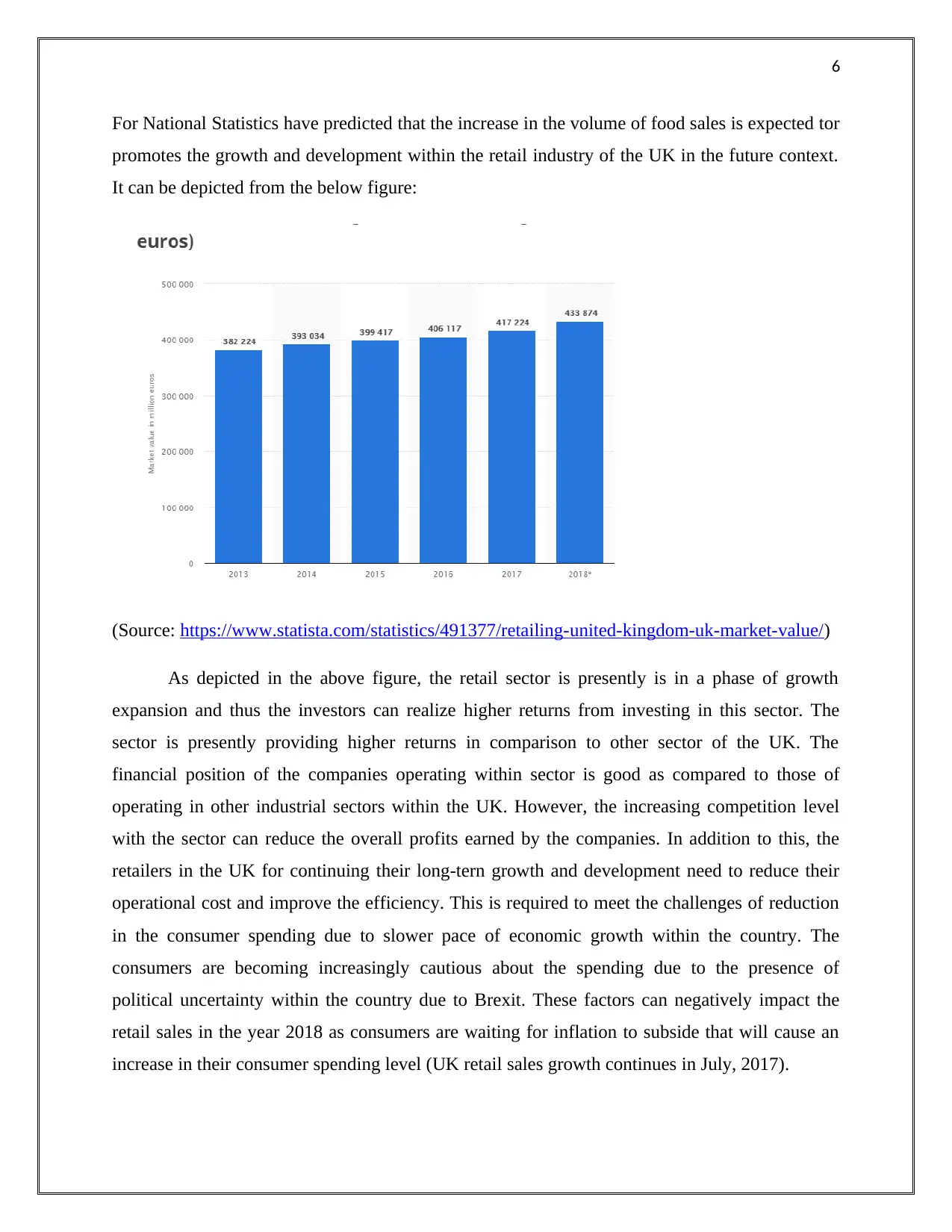
6
For National Statistics have predicted that the increase in the volume of food sales is expected tor
promotes the growth and development within the retail industry of the UK in the future context.
It can be depicted from the below figure:
(Source: https://www.statista.com/statistics/491377/retailing-united-kingdom-uk-market-value/)
As depicted in the above figure, the retail sector is presently is in a phase of growth
expansion and thus the investors can realize higher returns from investing in this sector. The
sector is presently providing higher returns in comparison to other sector of the UK. The
financial position of the companies operating within sector is good as compared to those of
operating in other industrial sectors within the UK. However, the increasing competition level
with the sector can reduce the overall profits earned by the companies. In addition to this, the
retailers in the UK for continuing their long-tern growth and development need to reduce their
operational cost and improve the efficiency. This is required to meet the challenges of reduction
in the consumer spending due to slower pace of economic growth within the country. The
consumers are becoming increasingly cautious about the spending due to the presence of
political uncertainty within the country due to Brexit. These factors can negatively impact the
retail sales in the year 2018 as consumers are waiting for inflation to subside that will cause an
increase in their consumer spending level (UK retail sales growth continues in July, 2017).
For National Statistics have predicted that the increase in the volume of food sales is expected tor
promotes the growth and development within the retail industry of the UK in the future context.
It can be depicted from the below figure:
(Source: https://www.statista.com/statistics/491377/retailing-united-kingdom-uk-market-value/)
As depicted in the above figure, the retail sector is presently is in a phase of growth
expansion and thus the investors can realize higher returns from investing in this sector. The
sector is presently providing higher returns in comparison to other sector of the UK. The
financial position of the companies operating within sector is good as compared to those of
operating in other industrial sectors within the UK. However, the increasing competition level
with the sector can reduce the overall profits earned by the companies. In addition to this, the
retailers in the UK for continuing their long-tern growth and development need to reduce their
operational cost and improve the efficiency. This is required to meet the challenges of reduction
in the consumer spending due to slower pace of economic growth within the country. The
consumers are becoming increasingly cautious about the spending due to the presence of
political uncertainty within the country due to Brexit. These factors can negatively impact the
retail sales in the year 2018 as consumers are waiting for inflation to subside that will cause an
increase in their consumer spending level (UK retail sales growth continues in July, 2017).
⊘ This is a preview!⊘
Do you want full access?
Subscribe today to unlock all pages.

Trusted by 1+ million students worldwide
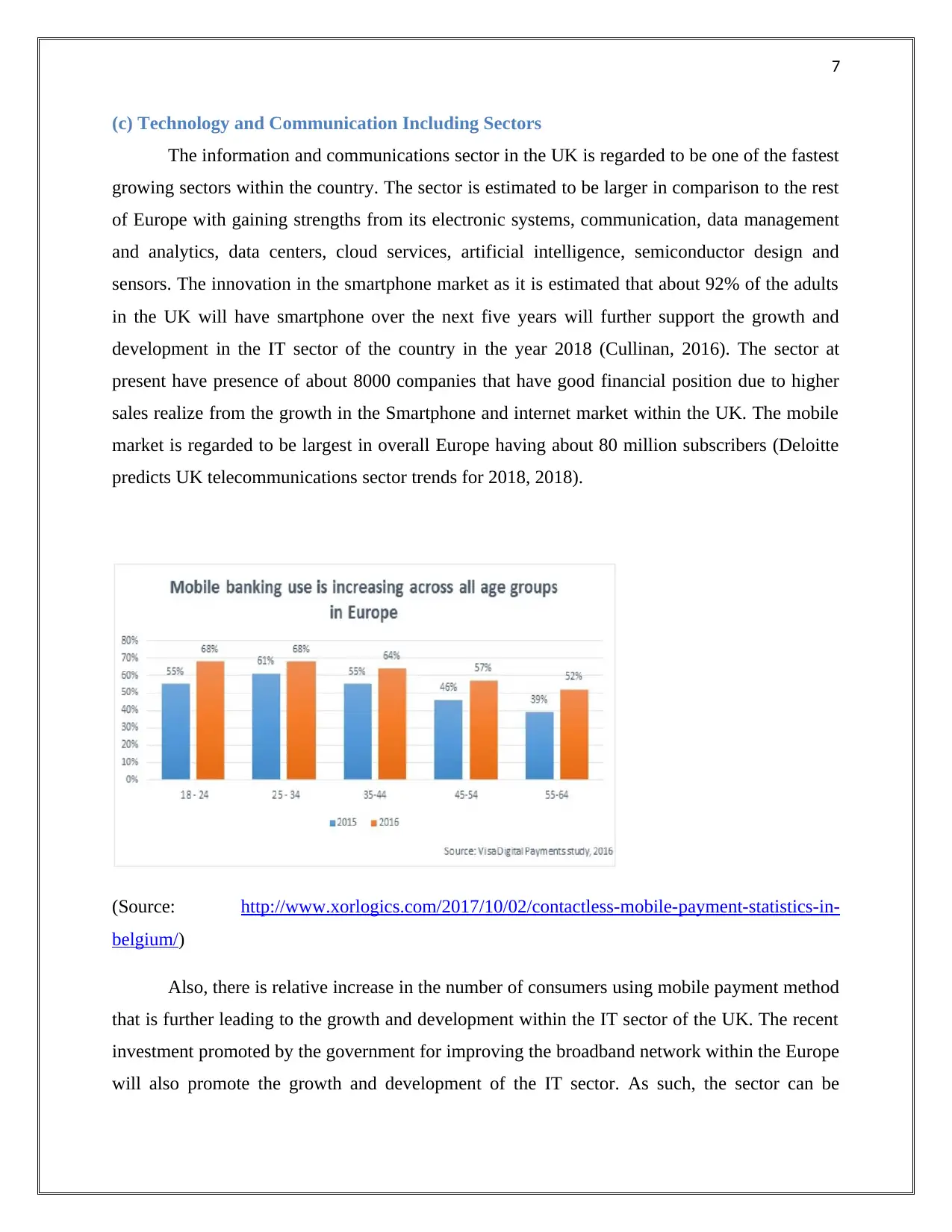
7
(c) Technology and Communication Including Sectors
The information and communications sector in the UK is regarded to be one of the fastest
growing sectors within the country. The sector is estimated to be larger in comparison to the rest
of Europe with gaining strengths from its electronic systems, communication, data management
and analytics, data centers, cloud services, artificial intelligence, semiconductor design and
sensors. The innovation in the smartphone market as it is estimated that about 92% of the adults
in the UK will have smartphone over the next five years will further support the growth and
development in the IT sector of the country in the year 2018 (Cullinan, 2016). The sector at
present have presence of about 8000 companies that have good financial position due to higher
sales realize from the growth in the Smartphone and internet market within the UK. The mobile
market is regarded to be largest in overall Europe having about 80 million subscribers (Deloitte
predicts UK telecommunications sector trends for 2018, 2018).
(Source: http://www.xorlogics.com/2017/10/02/contactless-mobile-payment-statistics-in-
belgium/)
Also, there is relative increase in the number of consumers using mobile payment method
that is further leading to the growth and development within the IT sector of the UK. The recent
investment promoted by the government for improving the broadband network within the Europe
will also promote the growth and development of the IT sector. As such, the sector can be
(c) Technology and Communication Including Sectors
The information and communications sector in the UK is regarded to be one of the fastest
growing sectors within the country. The sector is estimated to be larger in comparison to the rest
of Europe with gaining strengths from its electronic systems, communication, data management
and analytics, data centers, cloud services, artificial intelligence, semiconductor design and
sensors. The innovation in the smartphone market as it is estimated that about 92% of the adults
in the UK will have smartphone over the next five years will further support the growth and
development in the IT sector of the country in the year 2018 (Cullinan, 2016). The sector at
present have presence of about 8000 companies that have good financial position due to higher
sales realize from the growth in the Smartphone and internet market within the UK. The mobile
market is regarded to be largest in overall Europe having about 80 million subscribers (Deloitte
predicts UK telecommunications sector trends for 2018, 2018).
(Source: http://www.xorlogics.com/2017/10/02/contactless-mobile-payment-statistics-in-
belgium/)
Also, there is relative increase in the number of consumers using mobile payment method
that is further leading to the growth and development within the IT sector of the UK. The recent
investment promoted by the government for improving the broadband network within the Europe
will also promote the growth and development of the IT sector. As such, the sector can be
Paraphrase This Document
Need a fresh take? Get an instant paraphrase of this document with our AI Paraphraser
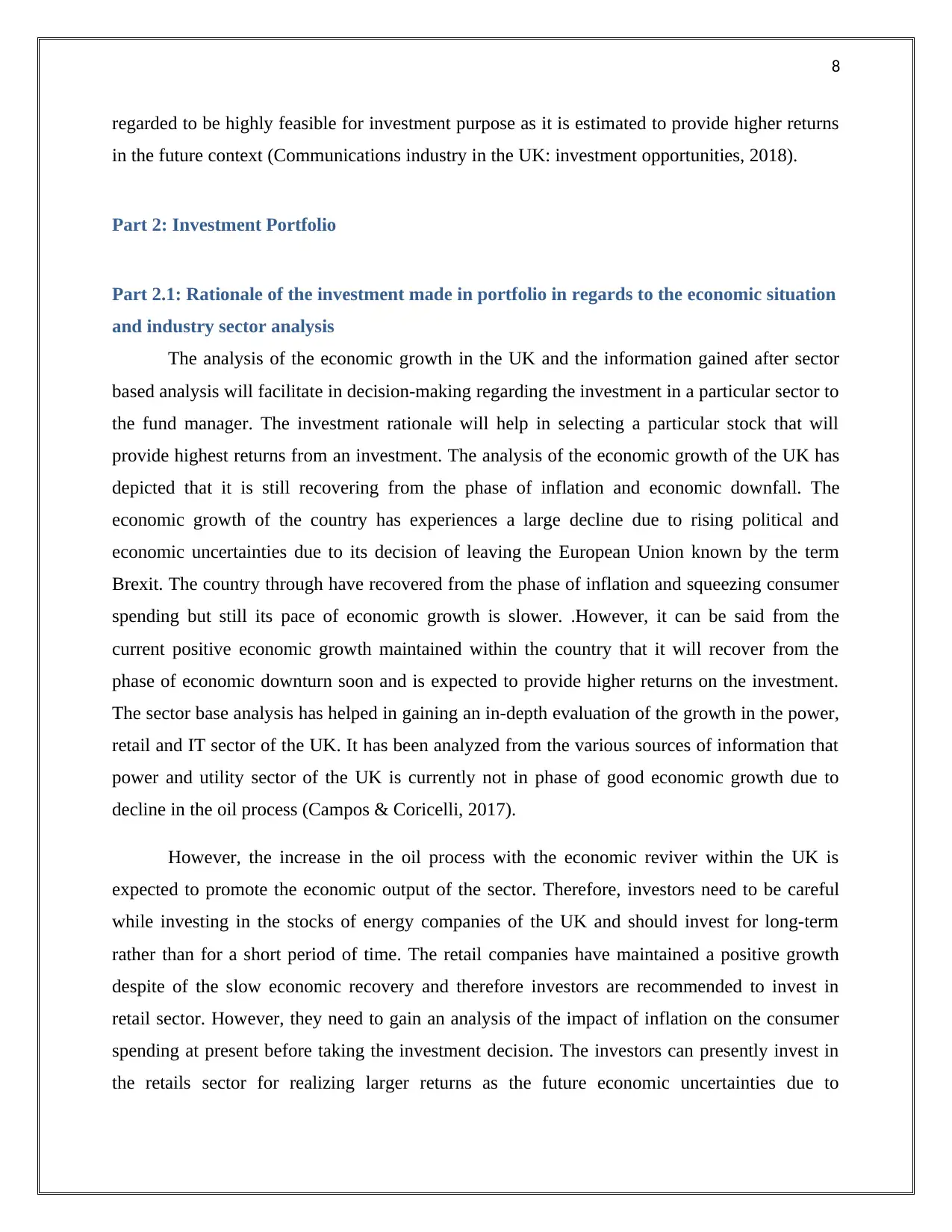
8
regarded to be highly feasible for investment purpose as it is estimated to provide higher returns
in the future context (Communications industry in the UK: investment opportunities, 2018).
Part 2: Investment Portfolio
Part 2.1: Rationale of the investment made in portfolio in regards to the economic situation
and industry sector analysis
The analysis of the economic growth in the UK and the information gained after sector
based analysis will facilitate in decision-making regarding the investment in a particular sector to
the fund manager. The investment rationale will help in selecting a particular stock that will
provide highest returns from an investment. The analysis of the economic growth of the UK has
depicted that it is still recovering from the phase of inflation and economic downfall. The
economic growth of the country has experiences a large decline due to rising political and
economic uncertainties due to its decision of leaving the European Union known by the term
Brexit. The country through have recovered from the phase of inflation and squeezing consumer
spending but still its pace of economic growth is slower. .However, it can be said from the
current positive economic growth maintained within the country that it will recover from the
phase of economic downturn soon and is expected to provide higher returns on the investment.
The sector base analysis has helped in gaining an in-depth evaluation of the growth in the power,
retail and IT sector of the UK. It has been analyzed from the various sources of information that
power and utility sector of the UK is currently not in phase of good economic growth due to
decline in the oil process (Campos & Coricelli, 2017).
However, the increase in the oil process with the economic reviver within the UK is
expected to promote the economic output of the sector. Therefore, investors need to be careful
while investing in the stocks of energy companies of the UK and should invest for long-term
rather than for a short period of time. The retail companies have maintained a positive growth
despite of the slow economic recovery and therefore investors are recommended to invest in
retail sector. However, they need to gain an analysis of the impact of inflation on the consumer
spending at present before taking the investment decision. The investors can presently invest in
the retails sector for realizing larger returns as the future economic uncertainties due to
regarded to be highly feasible for investment purpose as it is estimated to provide higher returns
in the future context (Communications industry in the UK: investment opportunities, 2018).
Part 2: Investment Portfolio
Part 2.1: Rationale of the investment made in portfolio in regards to the economic situation
and industry sector analysis
The analysis of the economic growth in the UK and the information gained after sector
based analysis will facilitate in decision-making regarding the investment in a particular sector to
the fund manager. The investment rationale will help in selecting a particular stock that will
provide highest returns from an investment. The analysis of the economic growth of the UK has
depicted that it is still recovering from the phase of inflation and economic downfall. The
economic growth of the country has experiences a large decline due to rising political and
economic uncertainties due to its decision of leaving the European Union known by the term
Brexit. The country through have recovered from the phase of inflation and squeezing consumer
spending but still its pace of economic growth is slower. .However, it can be said from the
current positive economic growth maintained within the country that it will recover from the
phase of economic downturn soon and is expected to provide higher returns on the investment.
The sector base analysis has helped in gaining an in-depth evaluation of the growth in the power,
retail and IT sector of the UK. It has been analyzed from the various sources of information that
power and utility sector of the UK is currently not in phase of good economic growth due to
decline in the oil process (Campos & Coricelli, 2017).
However, the increase in the oil process with the economic reviver within the UK is
expected to promote the economic output of the sector. Therefore, investors need to be careful
while investing in the stocks of energy companies of the UK and should invest for long-term
rather than for a short period of time. The retail companies have maintained a positive growth
despite of the slow economic recovery and therefore investors are recommended to invest in
retail sector. However, they need to gain an analysis of the impact of inflation on the consumer
spending at present before taking the investment decision. The investors can presently invest in
the retails sector for realizing larger returns as the future economic uncertainties due to
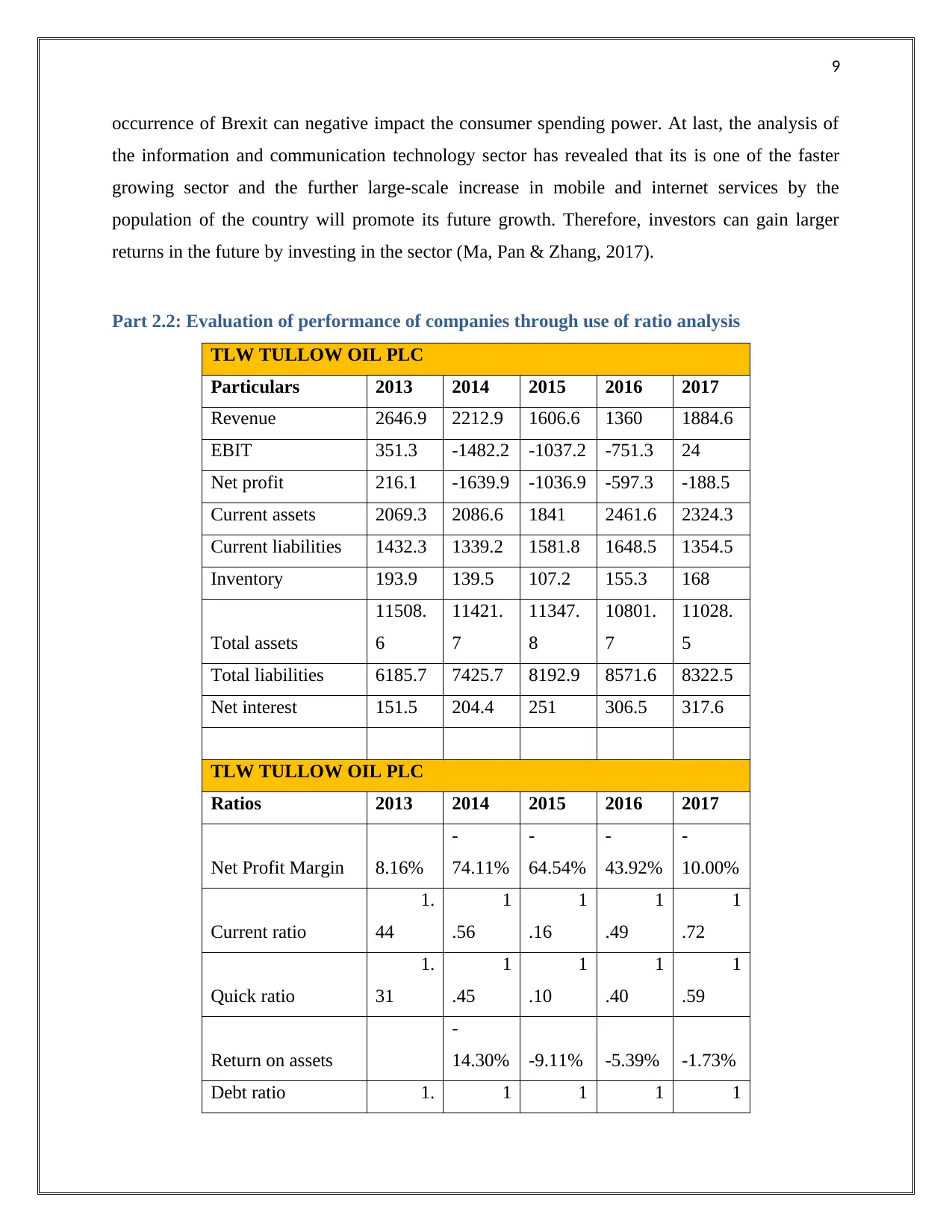
9
occurrence of Brexit can negative impact the consumer spending power. At last, the analysis of
the information and communication technology sector has revealed that its is one of the faster
growing sector and the further large-scale increase in mobile and internet services by the
population of the country will promote its future growth. Therefore, investors can gain larger
returns in the future by investing in the sector (Ma, Pan & Zhang, 2017).
Part 2.2: Evaluation of performance of companies through use of ratio analysis
TLW TULLOW OIL PLC
Particulars 2013 2014 2015 2016 2017
Revenue 2646.9 2212.9 1606.6 1360 1884.6
EBIT 351.3 -1482.2 -1037.2 -751.3 24
Net profit 216.1 -1639.9 -1036.9 -597.3 -188.5
Current assets 2069.3 2086.6 1841 2461.6 2324.3
Current liabilities 1432.3 1339.2 1581.8 1648.5 1354.5
Inventory 193.9 139.5 107.2 155.3 168
Total assets
11508.
6
11421.
7
11347.
8
10801.
7
11028.
5
Total liabilities 6185.7 7425.7 8192.9 8571.6 8322.5
Net interest 151.5 204.4 251 306.5 317.6
TLW TULLOW OIL PLC
Ratios 2013 2014 2015 2016 2017
Net Profit Margin 8.16%
-
74.11%
-
64.54%
-
43.92%
-
10.00%
Current ratio
1.
44
1
.56
1
.16
1
.49
1
.72
Quick ratio
1.
31
1
.45
1
.10
1
.40
1
.59
Return on assets
-
14.30% -9.11% -5.39% -1.73%
Debt ratio 1. 1 1 1 1
occurrence of Brexit can negative impact the consumer spending power. At last, the analysis of
the information and communication technology sector has revealed that its is one of the faster
growing sector and the further large-scale increase in mobile and internet services by the
population of the country will promote its future growth. Therefore, investors can gain larger
returns in the future by investing in the sector (Ma, Pan & Zhang, 2017).
Part 2.2: Evaluation of performance of companies through use of ratio analysis
TLW TULLOW OIL PLC
Particulars 2013 2014 2015 2016 2017
Revenue 2646.9 2212.9 1606.6 1360 1884.6
EBIT 351.3 -1482.2 -1037.2 -751.3 24
Net profit 216.1 -1639.9 -1036.9 -597.3 -188.5
Current assets 2069.3 2086.6 1841 2461.6 2324.3
Current liabilities 1432.3 1339.2 1581.8 1648.5 1354.5
Inventory 193.9 139.5 107.2 155.3 168
Total assets
11508.
6
11421.
7
11347.
8
10801.
7
11028.
5
Total liabilities 6185.7 7425.7 8192.9 8571.6 8322.5
Net interest 151.5 204.4 251 306.5 317.6
TLW TULLOW OIL PLC
Ratios 2013 2014 2015 2016 2017
Net Profit Margin 8.16%
-
74.11%
-
64.54%
-
43.92%
-
10.00%
Current ratio
1.
44
1
.56
1
.16
1
.49
1
.72
Quick ratio
1.
31
1
.45
1
.10
1
.40
1
.59
Return on assets
-
14.30% -9.11% -5.39% -1.73%
Debt ratio 1. 1 1 1 1
⊘ This is a preview!⊘
Do you want full access?
Subscribe today to unlock all pages.

Trusted by 1+ million students worldwide

10
86 .54 .39 .26 .33
Interest coverage
ratio
2.
32
(7.
25)
(4.
13)
(2.
45)
0
.08
EPS
0.
19
(1.
71)
(1.
14)
(0.
66)
(0.
15)
(London Stock Exchange, 2018)
The ratio analysis carried out for the TLW TULLOW OIL PIC will facilitate in
evaluating the performance of the company that operates in the energy sector of the UK. It can
be seen from the net profit ratio of the company for the period 2013-2017 that its profitability
position is declining and it is running at loss. The current ratio is increasing which depicts that its
current assets are increasing to current liabilities that can be positive sign for its future growth.
Also, its return on assets ratio has also shown a sharp decline and negative growth indicating the
company inefficiency to utilize its assets for generating income. The debt ratio has also decline
indicating that it is utilizing less use of financial leverage in financing its operations. The interest
coverage ratio has also reduced depicting the company less use of debt in comparison to equity
for funding its operational activities. This can be a sign of positive growth for the company with
the future increase in the oil prices. The Earning per Share (EPS) of the company has decreased
form the period 2013-2017 indicating that its ability to generate value for the shareholders has
reduced due to decline in its profitability position (Drake, 2006).
DOMINO'S PIZZA GROUP PLC
Particulars 2012 2013 2014 2015 2016
Revenue 240.52 268.9 294.38 316.79 360.58
EBIT 42.24 19.75 52.98 71.46 83.13
Net profit 29.88 11.48 41.69 57.56 65.24
Current assets 69.33 71.55 74.65 89.72 75.42
Current liabilities 52.42 61.39 78.59 71.34 84.39
Inventory 7.33 4.25 4.83 6.21 9.24
Total assets 181.78 166.43 165.2 185.45 256.37
Total liabilities 112.47 101.85 91.8 87.77 149.21
Net interest 0.26 0.6 0.56 0.12 0.71
86 .54 .39 .26 .33
Interest coverage
ratio
2.
32
(7.
25)
(4.
13)
(2.
45)
0
.08
EPS
0.
19
(1.
71)
(1.
14)
(0.
66)
(0.
15)
(London Stock Exchange, 2018)
The ratio analysis carried out for the TLW TULLOW OIL PIC will facilitate in
evaluating the performance of the company that operates in the energy sector of the UK. It can
be seen from the net profit ratio of the company for the period 2013-2017 that its profitability
position is declining and it is running at loss. The current ratio is increasing which depicts that its
current assets are increasing to current liabilities that can be positive sign for its future growth.
Also, its return on assets ratio has also shown a sharp decline and negative growth indicating the
company inefficiency to utilize its assets for generating income. The debt ratio has also decline
indicating that it is utilizing less use of financial leverage in financing its operations. The interest
coverage ratio has also reduced depicting the company less use of debt in comparison to equity
for funding its operational activities. This can be a sign of positive growth for the company with
the future increase in the oil prices. The Earning per Share (EPS) of the company has decreased
form the period 2013-2017 indicating that its ability to generate value for the shareholders has
reduced due to decline in its profitability position (Drake, 2006).
DOMINO'S PIZZA GROUP PLC
Particulars 2012 2013 2014 2015 2016
Revenue 240.52 268.9 294.38 316.79 360.58
EBIT 42.24 19.75 52.98 71.46 83.13
Net profit 29.88 11.48 41.69 57.56 65.24
Current assets 69.33 71.55 74.65 89.72 75.42
Current liabilities 52.42 61.39 78.59 71.34 84.39
Inventory 7.33 4.25 4.83 6.21 9.24
Total assets 181.78 166.43 165.2 185.45 256.37
Total liabilities 112.47 101.85 91.8 87.77 149.21
Net interest 0.26 0.6 0.56 0.12 0.71
Paraphrase This Document
Need a fresh take? Get an instant paraphrase of this document with our AI Paraphraser
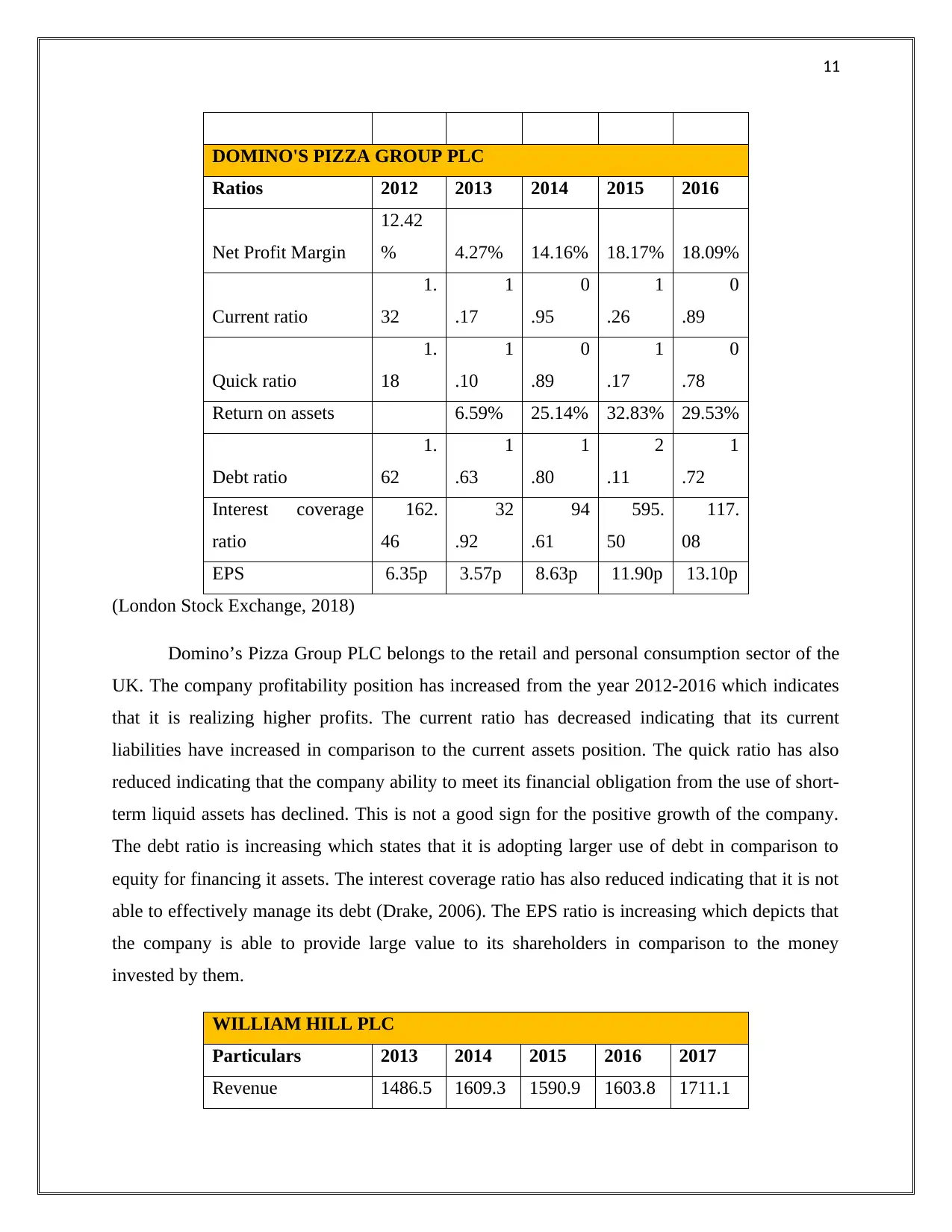
11
DOMINO'S PIZZA GROUP PLC
Ratios 2012 2013 2014 2015 2016
Net Profit Margin
12.42
% 4.27% 14.16% 18.17% 18.09%
Current ratio
1.
32
1
.17
0
.95
1
.26
0
.89
Quick ratio
1.
18
1
.10
0
.89
1
.17
0
.78
Return on assets 6.59% 25.14% 32.83% 29.53%
Debt ratio
1.
62
1
.63
1
.80
2
.11
1
.72
Interest coverage
ratio
162.
46
32
.92
94
.61
595.
50
117.
08
EPS 6.35p 3.57p 8.63p 11.90p 13.10p
(London Stock Exchange, 2018)
Domino’s Pizza Group PLC belongs to the retail and personal consumption sector of the
UK. The company profitability position has increased from the year 2012-2016 which indicates
that it is realizing higher profits. The current ratio has decreased indicating that its current
liabilities have increased in comparison to the current assets position. The quick ratio has also
reduced indicating that the company ability to meet its financial obligation from the use of short-
term liquid assets has declined. This is not a good sign for the positive growth of the company.
The debt ratio is increasing which states that it is adopting larger use of debt in comparison to
equity for financing it assets. The interest coverage ratio has also reduced indicating that it is not
able to effectively manage its debt (Drake, 2006). The EPS ratio is increasing which depicts that
the company is able to provide large value to its shareholders in comparison to the money
invested by them.
WILLIAM HILL PLC
Particulars 2013 2014 2015 2016 2017
Revenue 1486.5 1609.3 1590.9 1603.8 1711.1
DOMINO'S PIZZA GROUP PLC
Ratios 2012 2013 2014 2015 2016
Net Profit Margin
12.42
% 4.27% 14.16% 18.17% 18.09%
Current ratio
1.
32
1
.17
0
.95
1
.26
0
.89
Quick ratio
1.
18
1
.10
0
.89
1
.17
0
.78
Return on assets 6.59% 25.14% 32.83% 29.53%
Debt ratio
1.
62
1
.63
1
.80
2
.11
1
.72
Interest coverage
ratio
162.
46
32
.92
94
.61
595.
50
117.
08
EPS 6.35p 3.57p 8.63p 11.90p 13.10p
(London Stock Exchange, 2018)
Domino’s Pizza Group PLC belongs to the retail and personal consumption sector of the
UK. The company profitability position has increased from the year 2012-2016 which indicates
that it is realizing higher profits. The current ratio has decreased indicating that its current
liabilities have increased in comparison to the current assets position. The quick ratio has also
reduced indicating that the company ability to meet its financial obligation from the use of short-
term liquid assets has declined. This is not a good sign for the positive growth of the company.
The debt ratio is increasing which states that it is adopting larger use of debt in comparison to
equity for financing it assets. The interest coverage ratio has also reduced indicating that it is not
able to effectively manage its debt (Drake, 2006). The EPS ratio is increasing which depicts that
the company is able to provide large value to its shareholders in comparison to the money
invested by them.
WILLIAM HILL PLC
Particulars 2013 2014 2015 2016 2017
Revenue 1486.5 1609.3 1590.9 1603.8 1711.1

12
EBIT 299.6 280.8 221.6 224.1 -44.7
Net profit 223.1 205.3 187.2 163 -84.2
Current assets 272.7 282.2 342.9 291.7 393.4
Current liabilities 328.6 369.8 663.2 410.1 477.9
Inventory 0.2 0.1 0.1 0 0
Total assets 2413.9 2380.6 2346.7 2442.7 2362
Total liabilities 1390.6 1220.3 1130.9 1217.2 1299.3
Net interest 39.9 42.7 38.3 45.9 35.1
WILLIAM HILL PLC
Ratios 2014 2015 2016 2017
Net Profit Margin
15.01
% 12.76% 11.77% 10.16% -4.92%
Current ratio
0.
83
0
.76
0
.52
0
.71
0.
82
Quick ratio
0.
83
0
.76
0
.52
0
.71
0.
82
Return on assets 8.56% 7.92% 6.81% -3.50%
Debt ratio
1.
74
1
.95
2
.08
2
.01
1.
82
Interest coverage
ratio
7.
51
6
.58
5
.79
4
.88
(1.
27)
EPS 25.20p 23.60p 21.60p 18.90p 27.60p
(London Stock Exchange, 2018)
William Hill Plc belonging to technology and communication sector of the UK has
reported a decline in its profitability position form the year 2014-2017. The company has also
maintained a steady growth rate in the current ratio and quick ratio. This indicates the company
has just maintained a equal balance of its assets and liabilities. The return on assets has decreased
indicating that it is not able to utilize its assets effectively for generating sales. The debt ratio has
increased indicating more use of debt by the company. However, it has maintained steady growth
in the EPS indicating that the company is able to generate value for the shareholders.
EBIT 299.6 280.8 221.6 224.1 -44.7
Net profit 223.1 205.3 187.2 163 -84.2
Current assets 272.7 282.2 342.9 291.7 393.4
Current liabilities 328.6 369.8 663.2 410.1 477.9
Inventory 0.2 0.1 0.1 0 0
Total assets 2413.9 2380.6 2346.7 2442.7 2362
Total liabilities 1390.6 1220.3 1130.9 1217.2 1299.3
Net interest 39.9 42.7 38.3 45.9 35.1
WILLIAM HILL PLC
Ratios 2014 2015 2016 2017
Net Profit Margin
15.01
% 12.76% 11.77% 10.16% -4.92%
Current ratio
0.
83
0
.76
0
.52
0
.71
0.
82
Quick ratio
0.
83
0
.76
0
.52
0
.71
0.
82
Return on assets 8.56% 7.92% 6.81% -3.50%
Debt ratio
1.
74
1
.95
2
.08
2
.01
1.
82
Interest coverage
ratio
7.
51
6
.58
5
.79
4
.88
(1.
27)
EPS 25.20p 23.60p 21.60p 18.90p 27.60p
(London Stock Exchange, 2018)
William Hill Plc belonging to technology and communication sector of the UK has
reported a decline in its profitability position form the year 2014-2017. The company has also
maintained a steady growth rate in the current ratio and quick ratio. This indicates the company
has just maintained a equal balance of its assets and liabilities. The return on assets has decreased
indicating that it is not able to utilize its assets effectively for generating sales. The debt ratio has
increased indicating more use of debt by the company. However, it has maintained steady growth
in the EPS indicating that the company is able to generate value for the shareholders.
⊘ This is a preview!⊘
Do you want full access?
Subscribe today to unlock all pages.

Trusted by 1+ million students worldwide
1 out of 19
Related Documents
Your All-in-One AI-Powered Toolkit for Academic Success.
+13062052269
info@desklib.com
Available 24*7 on WhatsApp / Email
![[object Object]](/_next/static/media/star-bottom.7253800d.svg)
Unlock your academic potential
Copyright © 2020–2025 A2Z Services. All Rights Reserved. Developed and managed by ZUCOL.





